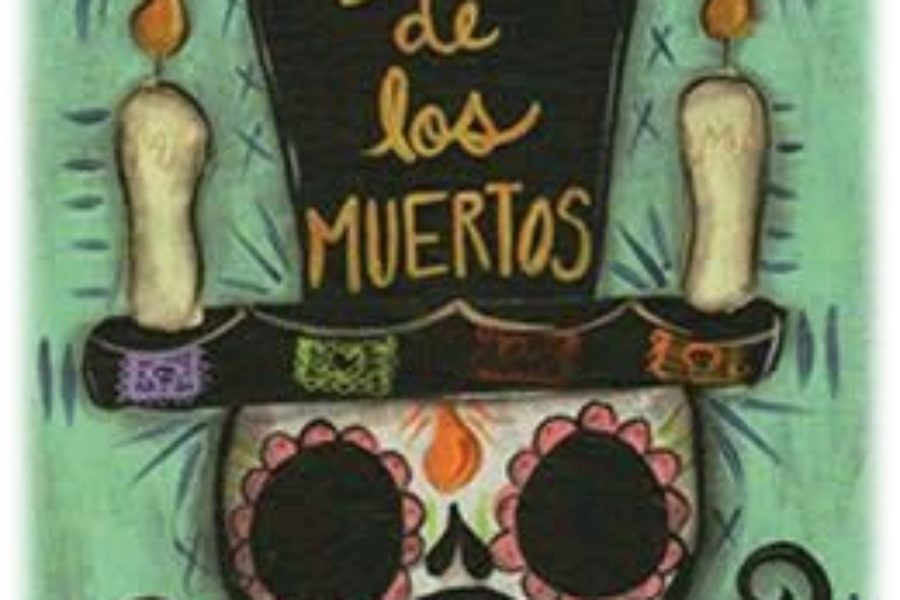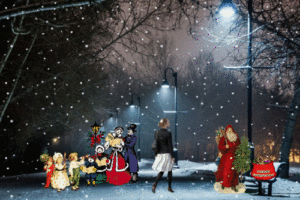ONE DARK AND RAINY HALLOWEEN
By Bernadette Inclan
It was an unusually cold day for October as Naomi drove her new Acura across Interstate Highway 35. She and her best friend, Clarissa, had taken a week off and decided to go into Mexico to visit Naomi’s family. They both had jobs in San Antonio, and the drive would only take three hours to the border town of Laredo. The young women traveled together on numerous occasions so even though this was Clarissa’s first adventure into Mexico, it was no big deal.
“Does Tia Fernanda know we’re coming?” Clarissa asked.
Clarissa had met Tia Fernanda on a few occasions and referred to her as “Tia” as a sign of respect.
“I called and let her know our approximate time of arrival,” Naomi answered.
Naomi eased into the International Border crossing. Their documents were in their purses. Since they were going more than 26-miles past the border, they had to get a tourist permit. Naomi had to register her vehicle, which had to be searched, so this was not going to be a quick getaway.
Naomi sighed deeply as she parked and walked into the building. She noticed that although there were a half-dozen windows, a long line of people waited patiently at the only one that was opened. She tip-toed to see over the line of people to what was the problem. Then she noticed the sign on the window; “Computadora abajo, perdon los inconvenientes.” The computers were down, and they were sorry for the inconvenience. The solitary man at the window was pecking at a manual typewriter. Naomi and Clarissa looked at each other, and both gave a deep sigh. They stood patiently as the line periodically moved.
“Siguente!, “Next!” shouted the agent. Both women walked confidently to the window.
“Where are you going?” asked the agent in Spanish without looking at either woman.
“Sabinas Hidalgo, Nuevo Leon,” answered Naomi.
The agent’s eyes moved up. He looked at Naomi, then at Clarissa. He shifted his position, and his manner became brusque.
“What are two women traveling alone doing in Mexico?” he asked in a gruff tone.
“Visiting family,” responded Naomi.
“You have no business traveling alone,” responded the agent.
“We’re traveling together,” Naomi indicated to Clarissa, “and I travel to Mexico at least once a month,” she snapped. Then, on second thought, decided to give the agent an ingratiating smile.
“Papers!” ordered the agent and began to type the forms they needed to present at the two upcoming check stations.
“Boy, that was close,” said Naomi as they drove through Nuevo Laredo for the highway that would take them to Sabinas Hidalgo, in the state of Nuevo Leon, “for a minute I thought we were going to be detained!”
“Why was he so aggressive? Asked Clarissa. “Hasn’t he gotten used to American Latina women being independent and assertive?”
Naomi laughed, “Maybe he was just vigilant. You’ve heard about the women murdered in Juarez, haven’t you?”
Naomi was referring to Juarez Mexico, the Bordertown of El Paso, Texas.
“No!” exclaimed Clarissa. “What is that about?”
“Read the book, If I Die in Juarez, by Phoenix author, Stella Pope Duarte. She writes about 500 young women between the ages of 11 and 22 that have been murdered in Juarez. The bodies show signs of sadistic torture and brutal sexual violence.
“How long has this been happening?” Clarissa asked incredulously.
“I suppose it came to light when the American companies, the maquiladoras, who own the factories, such as Ford, Motorola, Honeywell, would hire young women to work in their factories. Although the pay is less than half of what these women would earn in the United States, it’s a good living for poor women, who support their parents and families.
Both women were quiet as they headed out of the main city lights into the two-lane highway. The day was growing dark. Lightning pierced the darkening skies. Then, it began to rain.
“You know tonight is Halloween?” Clarissa said.

Image from Pinterest
“There’s nothing to worry about,” grinned Naomi, “Halloween isn’t celebrated in Mexico. What they have here is El Día de Los Muertos, the “Day of the Dead,” and that’s celebrated on November 1 and 2. I’m sure that you’ve heard of families gathering at the cemetery to pray for their loved ones who have died. The family cooks the favorite foods and drinks of the departed ones and take them to the cemetery.”
“Oh,” replied Clarissa solemnly, “I forgot about that. My family isn’t big into Hispanic culture.” She inched down into her seat and folded her arms tightly across her body.
“Stop worrying,” laughed Naomi, “this highway is used by the truckers carrying loads into Monterrey because they don’t want to pay the fee to use the toll roads. Monterrey is the capital of the northeastern Mexican state of Nuevo León and a sprawling business and industrial center.
“We’ll be fine,” Naomi tried to reassure.
But the road was long, dark and lonely; the rain relentless. Both women were quiet, and Naomi worked her fingers on her steering wheel to start a song on her playlist.
“How long will it take to get to Tia Fernanda’s,” whispered Clarissa. She was slowly losing her enthusiasm for a Mexican getaway.
“It’s usually a 90 minutes’ drive, but now that it’s raining so hard, it will definitely take longer,” Naomi answered.
“Oh boy,” said Clarissa, “this highway is pitch dark with no street lamps to light the way. Even the signs don’t reflect; you have to be on top of them to see what’s written.”
“Stop worrying,” soothed Naomi, “we’ll come up to a trucker soon.”
But it didn’t appear that there were other drivers on the forsaken highway. The women only occasionally saw a glow from a distant car passing from the opposite direction. But even these were few and very far between. Shadows danced in the distance as lightning bolts pierced the ebony skies.
Tish Hinojosa sang from the car’s stereo the mournful song, Los Golondrinas, the story of two lovebirds. Suddenly, a piercing sound shrilled through the speakers rendering the music unrecognizable.
“What happened?” shrieked Clarissa.
“Oh no,” wailed Naomi. “Just when we really need music. I hope my speakers didn’t blow.”
She switched to radio, but only persistent static came through the car’s speakers. As she touched the “Off” switch, she thought she felt a mild current shock her fingers.
“Thank you,” said Clarissa, as she put down her hands that had been covering her ears. “What an exciting adventure this is turning out to be. I think the goblins are out tonight.”
The rain came down in sheets obstructing visibility. If there were an impaired vehicle in front, Naomi would not be able to see it until the last second. She slowed down her car ever watchful of the dark road ahead.
“Tell me more about the book, If I Die in Juarez,” Clarissa said seeking a distraction from what felt like a perilous journey.
“Well,” Naomi began, “the story got its start when the journalist, Diana Washington Valdez, contacted Ms. Duarte about the murders. Ms. Valdez believes that the seedy underworld of Juarez’s narco-traffickers is responsible for what is being called a blood sport. The men are wealthy and have ties to the Juarez Cartel, and have used their drug wealth to build respectable businesses. According to Ms. Valdez, “It is one aspect of men in power, especially in a developing country. They know they can get away with outrageous behavior because they are more powerful than the police and the government.”
“That’s horrible,” Clarissa whispered. “If Ms. Valdez had the story, why didn’t she write it?”
“From what I understand,” responded Naomi, “Ms. Valdez has a contract on her life, and she has to maintain a shallow profile.”
“Then how does Ms. Duarte escape notice?” asked Clarissa.
“I’m not sure,” said Naomi, “but the book is about three fictitious characters whose story is based on actual events. I’m not sure if that’s the difference, but it would be interesting to find out.”
“What’s that ahead?” asked Clarissa nearing her face to the window before her.
The rain continued to slam the windshield, and while the wipers were at full speed, it was still difficult to see what was up ahead. Naomi dropped her speed even more.
“What do we have to protect ourselves if we have to leave the car?” asked Clarissa. “Do you carry a gun?”
“Of course not!” replied Naomi. “We wouldn’t have made past the border.”
“Ok, ok, just don’t stop. Whatever is in front of us is not in any hurry. I cannot make it out. It doesn’t appear to be a car,” said Clarissa.
Naomi squinted. She could see a huge form moving slowly. The shape was unrecognizable. The outline reminded her of the dust storms, called a Habub, she occasionally encountered on her trips to Arizona that would envelop a car into thick darkness. And while you always pulled over during one of these storms, she knew there was no way she was going to stop as she crept up behind this unknown carrier.
“What is it?” Clarissa whispered, her fear mounting.
“I don’t know.” answered Naomi, “It appears to be a horse and buggy.”
“Out here in this storm!” screeched Clarissa. “What is it carrying?”
“I can’t tell,” Naomi said, “but it looks like rolls of tumbleweed. What would someone be doing with dried twigs?” she whispered partly to herself.
“They should be really drenched by now,” replied Clarissa. “Pass him up, it’s giving me the creeps.”
Naomi looked to the dark road ahead, which offered no safe passing since its second lane was for oncoming traffic. However, her fear was mounting, so she decided to chance it. The rain belted her windshield. She would never see an oncoming car until it was too late.
“It was now or never!” she said to Clarissa who promptly covered her face with her hands.
She moved into the lane and stepped on the gas. As she hastened alongside the carrier, she noticed a figure shrouded in a heavy blanket. A flash of lightning made visible the black holes of what should have been the eyes. They seem to glow with the lightning. The horse was so black he appeared as if a shadow, ghostly in the darkness and blanket of pouring rain. A shiver ran up her spine.
When she was safely back on track, Naomi looked into her rear-view mirror.
“Oh my God!” she said almost in a whisper.
“What?” Clarissa uncovered her face to see that Naomi was looking into her mirror. She turned around to see what it was Clarissa was looking. She couldn’t see a thing.
“Where did it go?” she asked.
“It disappeared!” responded Naomi.
“Oh my gosh, this is so creepy, how much longer?” Clarissa asked. “Have we past the ghost town you told me about?”
“It should be coming up,” Naomi replied.
Sure enough, the lightning show pointed out the outlines of long abandoned haciendas that were once owned by the Spanish landed gentry.
“Over here,” Naomi pointed to Clarissa. “These were once magnificent homes left to decay when the Mexican revolutionaries seized back their land for distribution to peasants and soldiers.”
Clarissa squinted and peered into the dark pouring rain, not sure if she was seeing at what Naomi was pointing.
“They would gather tumbleweed brush and start fires in the barns,” Naomi continued. “When the owner ran out of his home to try and secure his property, the slaughter would begin.”
Clarissa shivered. “Do you believe that ghosts roam the land?” she asked.
“My parents would bring my brother and me to Sabinas when we were young. Dad would tell us stories of the wandering souls that were seen at night during El Día de Los Muertos. So, it wouldn’t surprise me,” replied Naomi.
“Lots of people were murdered and their bodies left to the vultures,” she continued, “It didn’t matter if you were a woman or a child. Those turbulent times left a lot of restless spirits, and there is talk that they do roam this land.”
“Hey,” she started mischievously, “this close to El Día de Los Muertos, we might see one or two.” She grinned at Clarissa, who was not amused.
“Boy, am I ready for city lights and action.” Clarissa moaned.
Naomi passed a small sign.
“Look, we’re nearing Vallecillo. That means that we’re only 15 kilometers, or less than 10 miles, from Sabinas.”
“This place also looks like a ghost town,” Clarissa murmured.

Image from Pinterest
“Well, almost,” said Naomi. “In its heyday, it was a famous silver mining town and home to the very wealthy. My dad and many of my ancestors were born here. Maybe you’d like to visit?” asked Naomi.
“In the daytime,” replied Clarissa. Right now, all I really want is to get to Tia Fernanda’s.”
“You know, it wasn’t the Spanish conquistadors who mined the silver, it was the native people. There was much suffering because the Spaniards didn’t think of them as truly human,” Naomi told Clarissa. “There’s a legend,” she continued, “that the souls of 1000 indigenous people walk the city at midnight, October 31, before the El Día de Los Muertos celebration begins. No one goes out after dark, and that’s the real reason the town looks deserted.
Clarissa trembled, “Enough!” she shouted to Naomi, “Enough of these stories. Why now, why this trip? It’s been spooky enough.”
Naomi laughed, “This trip just brings back memories with my parents and the stories my dad told us.” She looked out into the darkness. She thought she could see what appeared to be lights blinking in the remote, barren countryside. Suddenly, she too was ready for the familiar comforts of her aunt’s home.
They drove past the Sabinas Hidalgo sign. The rain abruptly stopped. The women looked at each other and shrugged.
“Maybe it’s a sign that we escaped the goblins,” Clarissa said. They smiled.
Naomi took the turns that would take them to Tia Fernanda’s house. It was well after midnight. The streets weren’t even wet, they noticed. When they arrived at the house, it was shrouded in darkness.
“Everyone’s in bed,” Clarissa said.
“I don’t think so,” answered Naomi. “Tia Fernanda said she would be up preparing the food for El Día de Los Muertos.”
“It’s close to 1 AM,” said Clarissa.
Both women got out of the car to enter the unlocked house. There were no lights on, and no one was home.
“What do we do now?” Clarissa asked.
“I think I know,” replied Naomi. “Come on, get back into the car.”
Naomi made her way through the city. She knew her way around, and before long both women could see the flickering of lights and dark shadows out in the distance.
“Now where are we going?” Clarissa asked shakily.
“It’s November 1,” replied Naomi. “El Día de Los Muertos has officially begun. We’re going to the cemetery.”
“By ourselves!” Clarissa cried out.
“No, we won’t be alone,” replied Naomi. “The whole family will be there. You’ll see.”
Sure enough, the cemetery was alight with burning candles on every gravestone. People milled around. Some were praying at their loved one’s grave. Others played their guitar or accordion and sang. Still, others just mingled together in celebration of a life of someone dear and much loved. Naomi parked the car and jumped out of the car. She pulled Clarissa by the hand and practically ran to the familiar mausoleum. There were Tia Fernanda and her cousins. A tablecloth on a marble bench was the setting for an array of delicacies made by Tia Fernanda and her daughters.
“You made it!” They all ran to embrace the women. “You are just in time for the celebration.”
About the Author:

Bernadette Inclan, SJHMC is a Cytotechnologist with St. Joseph’s Hospital Health Center in Phoenix, Az. She was a graduate student at the University of Texas at San Antonio and received her masters in Health Care Administration from Southwest Texas State. Originally from Galveston Texas, she has lived in San Antonio, San Diego, Ca. and now resides in Phoenix. In addition to her love of writing short stories, Bernadette does extensive research in the area of Mexican – American history and genealogy. She does most of her writing in this genre and has been published in genealogy publications. Bernadette is married with two sons and a granddaughter.




All Comments Are Welcome